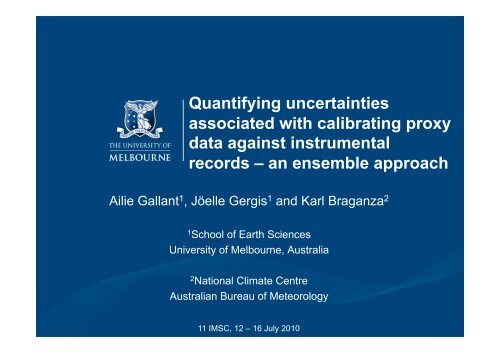Reconstructions
Reconstructions
Reconstructions
Create successful ePaper yourself
Turn your PDF publications into a flip-book with our unique Google optimized e-Paper software.
Quantifying uncertainties<br />
associated with calibrating proxy<br />
data against instrumental<br />
records – an ensemble approach<br />
Ailie Gallant 1 , Jöelle Gergis 1 and Karl Braganza 2<br />
1 School of Earth Sciences<br />
University of Melbourne, Australia<br />
2 National Climate Centre<br />
Australian Bureau of Meteorology<br />
11 IMSC, 12 – 16 July 2010
Outline<br />
1. Common methodological practices for<br />
developing reconstructions<br />
2. Calibrating to a single period – musings and<br />
questions arising<br />
3. An example using a multi-proxy<br />
reconstruction of southeast Australian<br />
rainfall and streamflow
Palaeoclimate reconstructions – common practice<br />
• Common practice is to calibrate against<br />
instrumental records<br />
– Use a portion of the instrumental record for calibration e.g.<br />
apply regression<br />
– Retain the remaining portion for independent verification of the<br />
record<br />
– The suitability and accuracy of the reconstruction is generally<br />
assessed using a suite of statistics (e.g. correlations, sign test,<br />
RMSE, RE, CE etc.)<br />
– These statistics are used to give an indication of the<br />
confidence we place in the accuracy of the reconstruction<br />
While the accuracy of the reconstruction is stated in terms of<br />
these validation statistics, there is no statement about the<br />
confidence in the numbers themselves…
Musings and questions<br />
If the choice of calibration/verification period and<br />
the lengths of these periods is arbitrary…<br />
1. How dependent is the final reconstruction to this arbitrary<br />
calibration period? Magnitude of sampling error?<br />
2. How is the validation and subsequent “accuracy” of the<br />
reconstruction affected by the arbitrary choice of<br />
calibration/verification period?<br />
3. The final reconstruction is often calibrated against the<br />
entire instrumental record, are we accurately estimating<br />
the regression coefficients? Are we tuning the<br />
reconstruction?
Should we use single/split period calibration?<br />
Proxies may be accepted/rejected as suitable for climate<br />
reconstruction based on these arbitrary choices, with no<br />
estimate as to how representative these statistics actually are<br />
and no estimation of the possible size of the sampling error<br />
associated with calibrating to one period.
An example: Rainfall reconstruction for SE Australia
Problems with the use of single/split calibration<br />
• Period of overlap with observations from 1900 – 1988<br />
• Split the time series in two:<br />
– Early period calibration (1900 – 1944)<br />
– Late period calibration (1945 – 1988)<br />
The verification statistics and the perceived accuracy of the reconstruction<br />
was strongly dependent on the choice of calibration/verification period
An ensemble approach to estimating uncertainty<br />
• Employed bootstrapping to generate an ensemble of<br />
reconstructions and verification statistics<br />
• Allows some quantification of sampling error in<br />
i. the verification statistics<br />
ii. the reconstruction associated with calibration (i.e. the<br />
dependence of the reconstruction on calibration period)<br />
• Random calibration intervals were generated using<br />
approximately half the data – selected in decadal blocks to<br />
maintain variability on the decadal and shorter scales<br />
• 10,000-member ensemble generated, decades used for<br />
generation of ensemble had a uniform distribution
Errors associated with calibration
<strong>Reconstructions</strong><br />
Annual reconstruction<br />
Decadal reconstruction<br />
• Can take the median of the<br />
ensemble as the “best<br />
estimate” of the reconstruction<br />
– resulting correlation very<br />
similar to “full period”<br />
calibration (both 0.57), but<br />
with better estimates of other<br />
measures of reconstruction<br />
accuracy<br />
• Perhaps a sign that using full<br />
period calibration is not tuning<br />
to 20 th century for this case?<br />
• Better to treat the<br />
reconstruction ensemble as a<br />
whole – also allows<br />
probabilistic estimates of the<br />
likelihood of a past climate
River Murray streamflow reconstruction:<br />
Potential amplification of errors associated<br />
with calibration
Probabilistic estimate of past climate<br />
• By using an ensemble, we can estimate the<br />
likelihood of a past event occurring rather than<br />
relying on en estimate from one realisation of a<br />
reconstruction<br />
• Example, streamflow reconstruction: The present<br />
day decadal-scale drought exceeds the median<br />
“best estimate”, but is not outside the range of the<br />
ensemble<br />
• 13% chance of droughts from 1783 – 1988<br />
exceeding present day drought (according to the<br />
reconstruction)
Summary<br />
• Serious weight is given to how we perceive the accuracy<br />
of a reconstruction by verifying to a particular period<br />
• The arbitrary choice of calibration/validation period can<br />
significant affect this perception and can also lead to the<br />
introduction of sampling errors in the reconstruction<br />
• Ensemble approach means we can have a “best estimate”<br />
while still retaining information on sampling errors<br />
• Can obtain a distribution of possible reconstructions back<br />
through time – allows from a probabilistic estimate of the<br />
likelihood of that reconstruction
THANK YOU<br />
agallant@unimelb.edu.au







![final_program_abstracts[1]](https://img.yumpu.com/19102520/1/174x260/final-program-abstracts1.jpg?quality=85)








